
Tungsten is a precious rare metal and an important strategic material, known as "the tooth of industry". At present, wolframite and scheelite are tungsten ores with industrial value. In China, wolframite mineral is the main source of tungsten development. However, most wolframite raw ore has a low grade, complex mineral composition, and relatively difficult beneficiation process.

At present, wolframite mineral beneficiation is generally divided into coarse-grained and fine-grained beneficiation, and we will mainly introduce these two aspects below.
The density of coarse-grained wolframite is 19 250kg/m3, which is quite different from gangue. Therefore, the beneficiation process is mainly gravity separation, like a jig, shaking table, spiral chute, and centrifugal concentrator.
1. Jig beneficiation process
Jig beneficiation is the process of separating ores by density in a vertically variable media flow. For coarse-grained wolframite, the jig is mainly used for three-stage jigging separation, that is, all wolframite is divided into three grades: coarse, medium, and fine. The particle size of coarse-grained jigging is 8mm-10mm (upper limit is 13mm), the range of medium-sized jigging is 1.5-5.mm, and the fine-grained jigging is less than 2mm. The tailings of particle size jig separation are reground and re-separated, and the fine particle size jig tailings are separated by shaking table after hydraulic classification.
The method has a large processing capacity, high separating efficiency, and low water consumption.
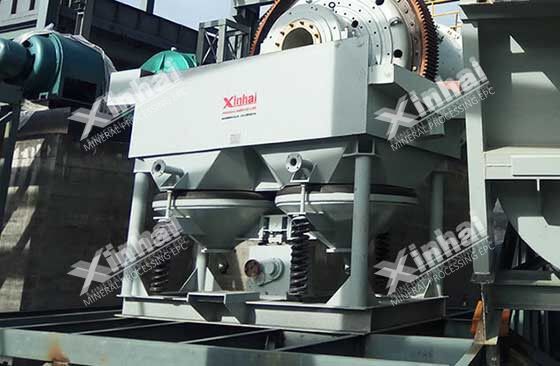
2. Shaking table beneficiation process
The use of a shaking table to process fine-grained wolframite relies on the combined action of mechanical asymmetric reciprocating motion and thin-layer inclined water flow to loosen and stratify the particles on the inclined bed, so as to realize the separation of tungsten and gangue minerals by density.
According to the different particle sizes of the selected tungsten ore, the shaking table can be divided into three types: coarse sand shaking table, fine sand shaking table, and ore mud shaking table. The particle size range of the coarse sand shaking table is 0.5-2mm, the fine sand shaker is 0.2-0.5mm, and the mud shaker is less than 0.2mm.
Note: Before the shaking table processing, the mineral particles should be hydraulically graded. The process is simple, the cost is low, the index is stable, and it will not cause environmental pollution.
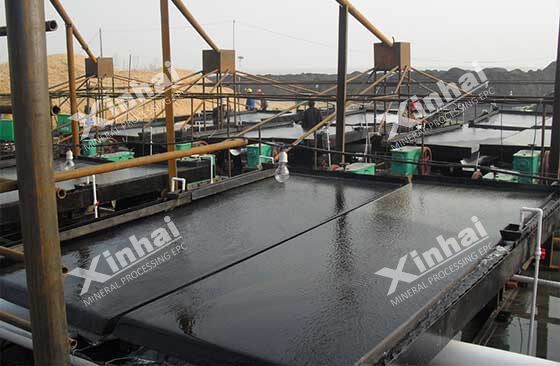
3. Spiral chute beneficiation process
Spiral chute beneficiation is that after the pulp enters the spiral chute, it spirals downward along the vertical central axis. Under the action of gravity and centrifugal force, the ore is layered (zoned) according to density and particle size. The high-density particles are in the lower layer, the low-density particles are in the upper layer, so as to realize the separation of tungsten ore and gangue minerals.
In wolframite beneficiation, the spiral chute is mostly used as a scavenging operation for tungsten fine mud, which has a large processing capacity, relatively small power consumption, and low water consumption. In addition, the separation process has both classification and desliming functions.
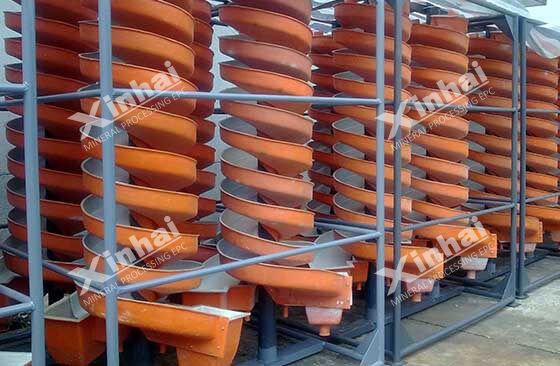
4. Centrifuge beneficiation process
The centrifuge beneficiation feeds the pulp along the tangential direction. When it rotates with the drum wall, it is subjected to centrifugal force and the action of the drum wall slope and stratified. The high-density particles form a sedimentary layer on the drum wall. The high-density particles form a sedimentary layer on the drum wall, and the low-density particles are discharged through the gap of the chassis together with the slurry flow, thereby achieving separation.
The lower limit of the recovery particle size of the centrifugal concentrator can reach 0.01 mm, which has the advantages of large processing capacity, fine recovery particle size, stable work, and easy operation. However, the enrichment of this equipment is relatively low and cannot be used continuously.
Wolframite is brittle, and it is easy to produce tungsten fine mud (-0.074 mm size) during the mining and beneficiation process. A single beneficiation method cannot effectively recover the fine-grained wolframite concentrate, so a combined process is often used, such as classification - gravity separation, gravity separation - flotation - gravity separation, strong magnetic separation - flotation, gravity separation - flotation (strong magnetic separation) combined beneficiation process, etc.
1. Classification - gravity separation
The process is to first concentrate the tungsten fine mud, then carry out coarse and fine classification, and divide it into two grades: +0.037mm and -0.037mm. The former is recovered by a shaking table, and the latter is separated by a centrifugal concentrator, which can make the total recovery rate reach 47% to 60%. Compared with the full shaking table beneficiation, the classification-gravity separation process improves the recovery capacity of the grain size wolframite, the operation is simple and the index is stable.
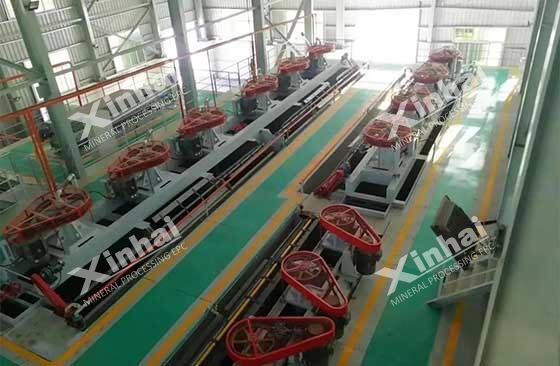
2. Gravity separation - flotation - gravity separation
The process is to concentrate the fine mud first, use a centrifugal concentrator for pre-enrichment to obtain coarse concentrate, and then adopt sulfide flotation for coarse concentrate. After flotation, the tailings are enriched with a shaking table to obtain wolframite concentrate.
Pre-separation before beneficiation can not only lose a large number of gangue minerals, but also play a role in desliming and pre-enrichment of fine mud, and improving the grade of ore feeding.
3. Strong magnetic separation – flotation
Wolframite has weak magnetic properties. Therefore, the coarse concentrate can be obtained by concentrating the fine mud. After the magnetic separation coarse concentrate is desulfurized by sulfide flotation, flotation reagents (fatty acid, hydroxamic acid, water glass, etc.) are added to separate wolframite.
This process can obtain high-grade tungsten fine mud concentrate (WO3 ≥50%), the recovery rate can reach 54%-65%, which needs few chemicals and has a short process flow. But most sulfide ores were discarded with the separation of the strong magnetic tailings.
4. Gravity separation - flotation (strong magnetic separation)
In this process, the tungsten fine mud is first desulfurized, then adopts rough separation of the tungsten fine mud with a centrifugal concentrator, and the obtained coarse concentrate is desulfurized again and then adopt flotation or strong magnetic separation to obtain tungsten fine mud concentrate.
The combined process of gravity separation and flotation can give full play to the role of the centrifugal concentrator, no need to classify, and has large processing capacity, the particle size of coarse concentrate can reach below 10μm.
The combined process is relatively simple, with less environmental pollution (basically no pollution), and the tungsten recovery rate can reach 65%.
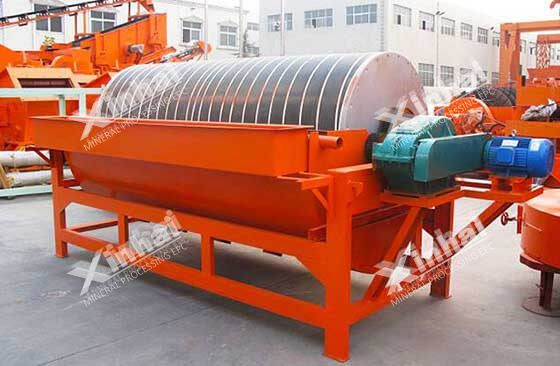
The above is the content of the wolframite mineral beneficiation process. In the production of processing plants, which process to choose depends on factors such as the nature of the ore, the conditions of the beneficiation plant, the investment budget, and so on. It is recommended to conduct a beneficiation test on wolframite first, and customize a suitable beneficiation process for tungsten ore according to the test results to obtain ideal beneficiation indicators and economic benefits.
To find out more about our products and solutions, please fill out the form below and one of our experts will get back to you shortly.